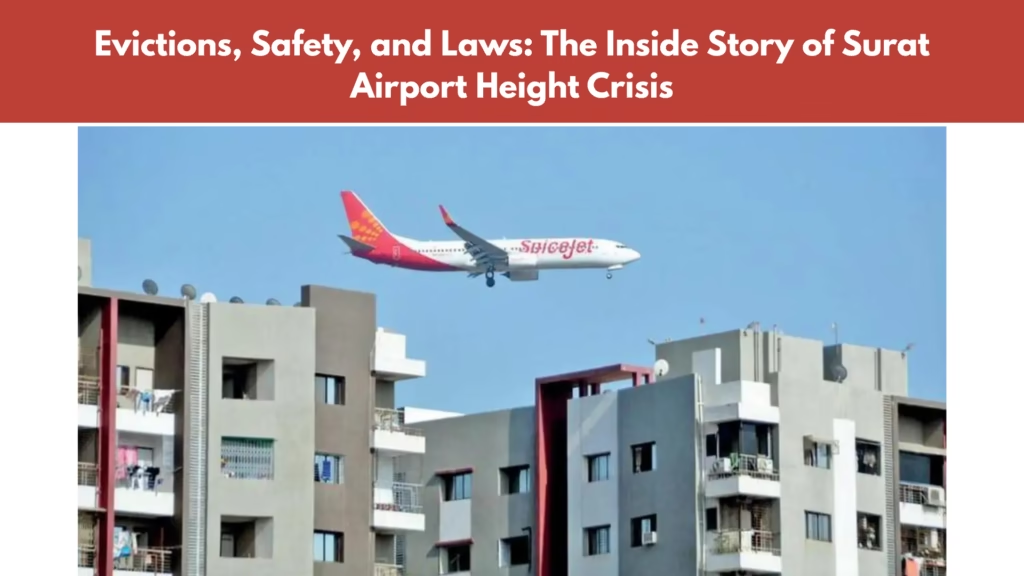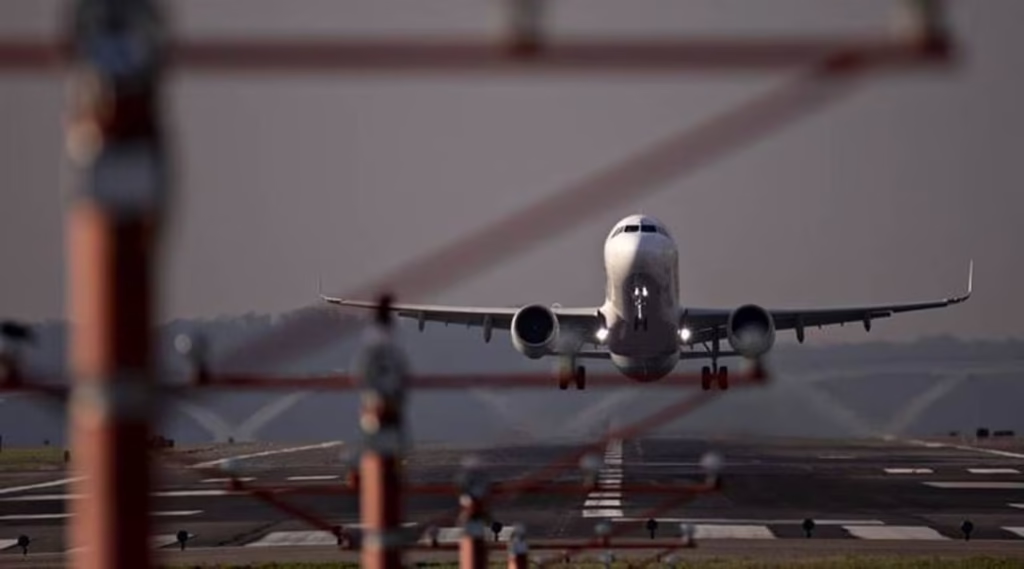Surat Airport Height Crisis: SMC’s Landmark Report & 151 Flat Eviction Notices

Surat Airport Height Crisis
Surat Airport Height Crisis : Urban expansion near airports brings both opportunity and risk. Surat, Gujarat—one of India’s fastest-growing cities—now faces a critical challenge: numerous high-rise buildings potentially violating height norms in Surat International Airport’s flight funnel. On June 17, 2025, the Surat Municipal Corporation (SMC) issued evacuation notices to 151 flat owners across luxury societies—Casa Riviera, KPM Terra, and Celestial Dreams—for lacking Building Use Certificates (BUCs), a move believed tied to height violations stipulated by the Airports Authority of India (AAI).
This blog explores the entire scenario in exhaustive detail: the genesis of the height obstacle issue, the SMC’s legal and technical stance, repercussions for affected residents, coordination with AAI and district authorities, legal dynamics, and broader urban planning lessons.

1. Anatomy of the Surat Airport Height Crisis
1.1 Airport-Safety Norms: Why Height Matters
Regulatory frameworks—especially from the AAI — mandate strict Height Obstacle Surfaces (HOS) around airports, defining the maximum permissible building elevation. These controls ensure safe take-off, landing, and flight operations. Any infringement could endanger aircraft maneuvering, reduce runway usability, and escalate safety risks.
In Surat, over 90 buildings—mostly in the Vesu area—are reportedly in violation, some exceeding the allowed height by over 14 meters. Despite Local Authority-issued BUCs, these structures intrude into HOS, provoking regulatory alarm
1.2 Seedbed: Ahmedabad Air Crash & Surat Airport
The turning point was the Air India Flight 171 crash in Ahmedabad earlier this month. Though unrelated to height issues, the accident heightened scrutiny on buildings within airport funnels nationwide. Surat’s civic and aviation bodies responded with renewed urgency, launching resurvey initiatives and crackdown plans on height-offending constructions .
2. The Eviction Notices: 151 Luxury Flats
2.1 What Drives the Notices?
On June 17, 2025, SMC issued official notices to residents in 10 towers spread across three upscale societies—36 flats in Casa Riviera, 74 in KPM Terra, and 41 in Celestial Dreams — demanding evacuation within three days. The buildings had no valid BUCs due to multiple regulatory lapses: exceeding AAI height norms, incomplete safety compliance, and urban planning violations .
SMC announced it would disconnect water and drainage lines if vacate orders aren’t complied with, signaling strict enforcement.
2.2 Builders vs. Residents: Whose Responsibility?
Owners argue they obtained all necessary permits for construction and occupancy, holding the builders accountable. They have approached courts, seeking reprieves—claiming regulatory frameworks allowed them to proceed with due approvals. Meanwhile, SMC maintains it’s enforcing building bylaws and cannot allow illegal structures to remain occupied.
3. Coordinated Enforcement: AAI, SMC & District Collector
3.1 Resurvey & Demolition Plans
Following the Ahmedabad crash, a collaborative resurvey commenced between AAI, SMC, and the district collector’s office to identify buildings breaching HOS. About six projects — without ongoing legal stays — have been earmarked for “height obstacle” removals, possibly including partial demolitions
3.2 Legal Safeguards & Court Stays
Approximately 110 other buildings are in legal limbo: cases pending in courts have placed action on hold. Once judicial stays are lifted, further notices and action—including demolitions—will proceed. Meanwhile, SMC is challenging these stays and gathering height compliance data
3.3 Shrimp Farms: A Hidden Airport Risk
In an allied note on airport safety, the district collector ordered removal of shrimp farms near Kankra rivulet—citing frequent flooding and bird attraction. Bird strikes are a known hazard to aircraft, and clearing these farmlands forms part of risk-mitigation efforts

4. Technical Implications — Runway Constraints and Infrastructure
4.1 Shrinking Runway: Impact of Height Violations
HOS-regulated height infringements have forced displacement of Runway 22 by 615 meters, reducing its usable length from 2,905 m to 2,290 m. The shorter runway hampers runway capacity and restricts operations during inclement conditions .
4.2 Illumination & Radar Saga
Surat Airport’s expansion plan — intended to install CAT‑I approach lighting and ASR‑MSSR radar—required 25.33 acres of land. However, in June 2025, AAI placed land acquisition on hold, citing cost concerns and lack of severe visibility issues (only three diversions due to fog last year). Critics warn that reduced runway length considerably elevates operational risk without technological mitigation
5. The Human Toll: Residents’ Voices
5.1 Shock, Uncertainty & Identity
Residents woke up to legal notices. Many families — newly moved in — are grappling with job changes, school transfers, and financial turmoil. Some recount signage: “Mane to navi flat leli hati… legal nathi?” (“I just bought a new flat… isn’t it legal?”
Legal costs, emotional stress, and short timelines have triggered outrage. Presently, many are in court, fighting SMC’s eviction, while others face disconnection of essential services.
5.2 Accountability & Scapegoating
Criticism is split: authorities blame developers for non-compliance; residents and consumer groups accuse SMC of inadequate monitoring and late enforcement. The real question: why were these violations not identified before occupancy?
6. Legal & Policy Fault Lines Surat Airport Height Crisis
6.1 Municipal Oversight vs. Private Development
SMC is tasked under the Gujarat Development Control Regulations (GDCR) to verify building heights with respect to roads, airport zones, and safety norms. High-rise building permits require rigorous documentation at each construction stage — including height certifications and safety checks . But evidence suggests these controls were bypassed or inadequately monitored.
6.2 Judicial Intervention: A Double-Edged Sword
Court orders balance citizens’ rights and safety imperatives.While stays protect residents from illegal eviction, they also delay urgent safety actions.The judicial pendulum now weighs heavily on technical evidence, surveys, and government urgency.
6.3 Calls for Reform
Surat Airport Experts argue for stronger frameworks:
- Mandatory pre-occupancy audits, ensuring BUC issuance only after confirming AAI clearance.
- Real-time violations dashboard accessible by public to flag at-risk buildings.
- Strict penalties for developers and municipal officials for non-compliance.
- Community engagement in pre-approval review—especially for structures within HOS zones.
7. Risk, Regulation, and Real Estate: A City-wide Wake-up Call
7.1 Market Repercussions
The remanding of BUCs and hospital notices reset buyer confidence. Surat’s apartment boom—feverish in areas like Vesu, Althan, Piplod—may slacken as legal compliance becomes non-negotiable.
7.2 Infrastructure & Planning Interplay
Rapid urbanization must dovetail with aviation safety—roads, drainage, building heights, cultural spaces, and flood zones (like the shrimp farms). Surat’s Smart City plan and master development blueprint must now confront this complexity
7.3 Regional Aviation Governance
Surat’s crisis echoes national discussions: rising flight volumes, denser urban settlements, and negligence in enforcing HOS height norms. The Ahmedabad incident triggered a domino effect—but Surat’s crisis shows that city-level oversight is vital to enforce AAI thresholds.

8. Next Steps: Syllabus for Safety Surat Airport
- Finalization of AAI’s height-obstacle report, due soon. This defines which buildings must be modified or destroyed.
- SMC-Mayor & Municipal Commissioner’s accountability will strengthen transparency, especially given their leadership in enforcing BUC norms
- Legal timeline: pending cases reach High Court; stay orders are negotiated.
- Demolition and Height Clearances: For stalled properties, height reductions and service restorations must be executed swiftly.
- Policy Revisions: Integrate pre-occupancy AAI clearance as a prerequisite for BUC and sale approvals.
9. Conclusion of Surat Airport
Surat Airport Height Crisis – Surat’s situation isn’t just local—it’s landmark. The city’s airport safety plan, intertwined with urban planning and real estate, has collided with reality. The SMC’s urgent eviction notices highlight the seriousness of invoking regulatory powers—and its timing sends a message: No shortcuts in infrastructure, no lapses in safety compliance, and no tolerance for negligence.
Surat’s lesson is national: aviation safety must keep pace with urban growth, guided by data, law, and civic responsibility. As stakeholders scramble—residents, builders, regulators, and courts—it’s time for holistic reform. Only then can Surat Airport — an aspirational Smart City—realize its vision, combining high-rise development with collision-free skyways.




